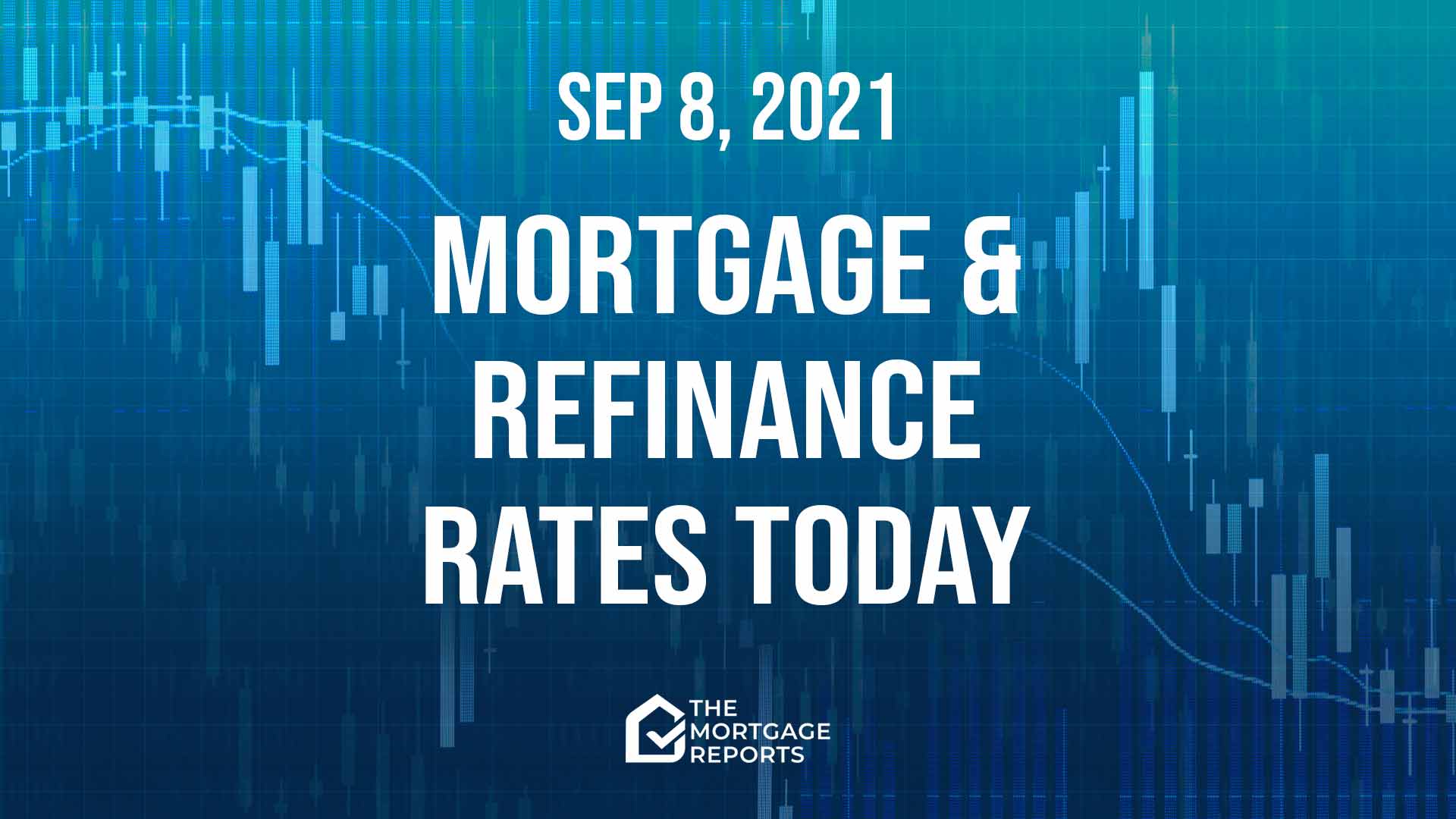
Today’s mortgage and refinance rates
Average mortgage rates edged higher again yesterday. And it’s been more than a week since they fell. But don’t panic. They’re still extraordinarily low.
And, first thing this morning, it’s looking likely that mortgage rates today will hold steady or inch lower. But that could change as the hours pass.
Find and lock a low rate (Sep 9th, 2021)Current mortgage and refinance rates
| Program | Mortgage Rate | APR* | Change |
|---|---|---|---|
| Conventional 30 year fixed | |||
| Conventional 30 year fixed | 2.813% | 2.813% | Unchanged |
| Conventional 15 year fixed | |||
| Conventional 15 year fixed | 2.009% | 2.009% | +0.02% |
| Conventional 20 year fixed | |||
| Conventional 20 year fixed | 2.49% | 2.49% | Unchanged |
| Conventional 10 year fixed | |||
| Conventional 10 year fixed | 1.897% | 1.947% | +0.02% |
| 30 year fixed FHA | |||
| 30 year fixed FHA | 2.688% | 3.343% | Unchanged |
| 15 year fixed FHA | |||
| 15 year fixed FHA | 2.4% | 3.001% | Unchanged |
| 5/1 ARM FHA | |||
| 5/1 ARM FHA | 2.5% | 3.213% | Unchanged |
| 30 year fixed VA | |||
| 30 year fixed VA | 2.271% | 2.442% | +0.02% |
| 15 year fixed VA | |||
| 15 year fixed VA | 2.25% | 2.571% | Unchanged |
| 5/1 ARM VA | |||
| 5/1 ARM VA | 2.5% | 2.392% | Unchanged |
| Rates are provided by our partner network, and may not reflect the market. Your rate might be different. Click here for a personalized rate quote. See our rate assumptions here. | |||
COVID-19 mortgage updates: Mortgage lenders are changing rates and rules due to COVID-19. To see the latest on how coronavirus could impact your home loan, click here.
Should you lock a mortgage rate today?
A week of small rises has pushed average mortgage rates toward the top of their recent narrow range. But there are early (and as yet uncertain) signs that the upward pressure is beginning to melt away. That would be no surprise. I’m yet to spot any signs of future influences that might push those rates far — either up or down — in the coming weeks.
But they’ll inevitably begin to move more decisively at some point. And, when they do, it’s more likely that they’ll rise than fall.
So, for now, my personal rate lock recommendations remain:
- LOCK if closing in 7 days
- LOCK if closing in 15 days
- LOCK if closing in 30 days
- FLOAT if closing in 45 days
- FLOAT if closing in 60 days
However, I don’t claim perfect foresight. And your personal analysis could turn out to be as good as mine — or better. So you might choose to be guided by your instincts and your personal tolerance for risk.
Market data affecting today’s mortgage rates
Here’s a snapshot of the state of play this morning at about 9:50 a.m. (ET). The data, compared with roughly the same time yesterday, were:
- The yield on 10-year Treasury notes inched down to 1.36% from 1.37%. (Good for mortgage rates.) More than any other market, mortgage rates normally tend to follow these particular Treasury bond yields
- Major stock indexes were mostly a little lower shortly after opening. (Good for mortgage rates.) When investors are buying shares they’re often selling bonds, which pushes prices of those down and increases yields and mortgage rates. The opposite may happen when indexes are lower
- Oil prices rose to $69.45 from $68.71 a barrel. (Bad for mortgage rates*.) Energy prices play a large role in creating inflation and also point to future economic activity.
- Gold prices fell to $1,796 from $1,816 an ounce. (Bad for mortgage rates*.) In general, it’s better for rates when gold rises, and worse when gold falls. Gold tends to rise when investors worry about the economy. And worried investors tend to push rates lower
- CNN Business Fear & Greed index — inched down to 51 from 54 out of 100. (Good for mortgage rates.) “Greedy” investors push bond prices down (and interest rates up) as they leave the bond market and move into stocks, while “fearful” investors do the opposite. So lower readings are better than higher ones
Caveats about markets and rates
Before the pandemic and the Federal Reserve’s interventions in the mortgage market, you could look at the above figures and make a pretty good guess about what would happen to mortgage rates that day. But that’s no longer the case. We still make daily calls. And are usually right. But our record for accuracy won’t achieve its former high levels until things settle down.
So use markets only as a rough guide. Because they have to be exceptionally strong or weak to rely on them. But, with that caveat, so far mortgage rates today look likely to either remain unchanged or inch downward. But be aware that “intraday swings” (when rates change direction during the day) are a common feature right now.
Find and lock a low rate (Sep 9th, 2021)
Important notes on today’s mortgage rates
Here are some things you need to know:
- Typically, mortgage rates go up when the economy’s doing well and down when it’s in trouble. But there are exceptions. Read ‘How mortgage rates are determined and why you should care
- Only “top-tier” borrowers (with stellar credit scores, big down payments and very healthy finances) get the ultralow mortgage rates you’ll see advertised
- Lenders vary. Yours may or may not follow the crowd when it comes to daily rate movements — though they all usually follow the wider trend over time
- When daily rate changes are small, some lenders will adjust closing costs and leave their rate cards the same
- Refinance rates are typically close to those for purchases. And a recent regulatory change has narrowed a gap that previously existed
So there’s a lot going on here. And nobody can claim to know with certainty what’s going to happen to mortgage rates in coming hours, days, weeks or months.
Are mortgage and refinance rates rising or falling?
Today and soon
A couple of weeks ago, I promised to avoid talking about tapering for a while. But it’s raised its ugly head again. So here goes.
Tapering is the term for when the Federal Reserve slows and then stops a program whereby it purchases bonds. That’s important for mortgage rates because it’s currently buying $45 billion-worth of mortgage-backed securities (MBSs) every month. And those securities are the bonds that largely determine mortgage rates.
That $45 billion is probably the single biggest factor in today’s uberlow mortgage rates. Because the extra demand it creates is pushing prices of MBSs higher, which — as a mathematical certainty — lowers those bonds’ yields. And low MBS yields mean low mortgage rates.
The Fed knows it has to taper those purchases sometime soon and has signaled that it will do so later this year. But last Friday’s disappointing jobs report caused many to think that the Fed would delay tapering for as long as it could. That’s why mortgage rates counterintuitively rose last Friday and yesterday.
Fed bombshell
But markets may have misread the Fed’s intentions. Because this morning’s Financial Times (paywall) carries an interview with St. Louis Federal Reserve Bank President James Bullard. And he strenuously advocates for the Fed to plow ahead with tapering as soon as possible, which could be as soon as Sept. 22. The FT reported:
The Federal Reserve should press ahead with a plan to dial down its massive pandemic stimulus program despite an abrupt slowdown in US jobs growth last month, according to a top central bank official.
James Bullard, president of the St Louis Fed, dismissed concerns the labor market recovery was faltering, even after just 235,000 jobs were created in the month of August, and reiterated his call for the central bank to begin scaling back or “tapering” its massive $120bn-a-month bond-buying program soon.
For those without an FT subscription, Reuters has a report of Mr. Bullard’s comments. Oh, and that $120 billion reference includes all the bonds the Fed is buying. Its MBS purchases alone are $45 billion.
Now, it’s important to recognize that Mr. Bullard is just one voice within the Fed, though he is known to have the support of others. And plenty of powerful officials within the organization are more cautious than he is.
So we may well see no shift in the current tapering policy in a couple of weeks’ time, which is when the Fed’s monetary policy committee next meets. But we can no longer dismiss the possibility.
For more background, read Saturday’s weekend edition of this column. And my colleague Tim Lucas’s longer-term forecast, Mortgage interest rates forecast and trends: Will rates go down in September 2021?
Recently
Over much of 2020, the overall trend for mortgage rates was clearly downward. And a new, weekly all-time low was set on 16 occasions last year, according to Freddie Mac.
The most recent weekly record low occurred on Jan. 7, when it stood at 2.65% for 30-year fixed-rate mortgages. But then the trend reversed and rates rose.
However, those rises have been mostly replaced by falls since April, though typically small ones. Freddie’s Sept. 2 report puts that weekly average at 2.87% (with 0.6 fees and points), unchanged from the previous week’s 2.87%.
Expert mortgage rate forecasts
Looking further ahead, Fannie Mae, Freddie Mac and the Mortgage Bankers Association (MBA) each has a team of economists dedicated to monitoring and forecasting what will happen to the economy, the housing sector and mortgage rates.
And here are their current rate forecasts for the remaining quarters of 2021 (Q3/21 and Q4/21) and the first two quarters of 2022 (Q1/22 and Q2/22).
The numbers in the table below are for 30-year, fixed-rate mortgages. Fannie’s and the MBA’s were updated on Aug. 19. But Freddie’s were last refreshed on July 15 because it now publishes these figures only quarterly. And its forecast is already looking stale.
| Forecaster | Q3/21 | Q4/21 | Q1/22 | Q2/22 |
| Fannie Mae | 2.8% | 2.9% | 3.0% | 3.0% |
| Freddie Mac | 3.3% | 3.4% | 3.5% | 3.6% |
| MBA | 2.9% | 3.3% | 3.5% | 3.7% |
However, given so many unknowables, the whole current crop of forecasts might be even more speculative than usual.
All these forecasts expect higher mortgage rates soon. But the differences between the forecasters are stark. And it may be that Fannie isn’t building in the Federal Reserve’s tapering of its support for mortgage rates while Freddie and the MBA are.
Find your lowest rate today
Some lenders have been spooked by the pandemic. And they’re restricting their offerings to just the most vanilla-flavored mortgages and refinances.
But others remain brave. And you can still probably find the cash-out refinance, investment mortgage or jumbo loan you want. You just have to shop around more widely.
But, of course, you should be comparison shopping widely, no matter what sort of mortgage you want. As federal regulator the Consumer Financial Protection Bureau says:
Shopping around for your mortgage has the potential to lead to real savings. It may not sound like much, but saving even a quarter of a point in interest on your mortgage saves you thousands of dollars over the life of your loan.
Verify your new rate (Sep 9th, 2021)



